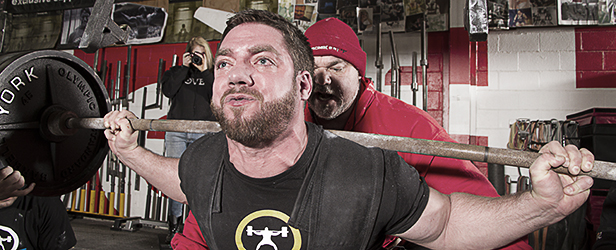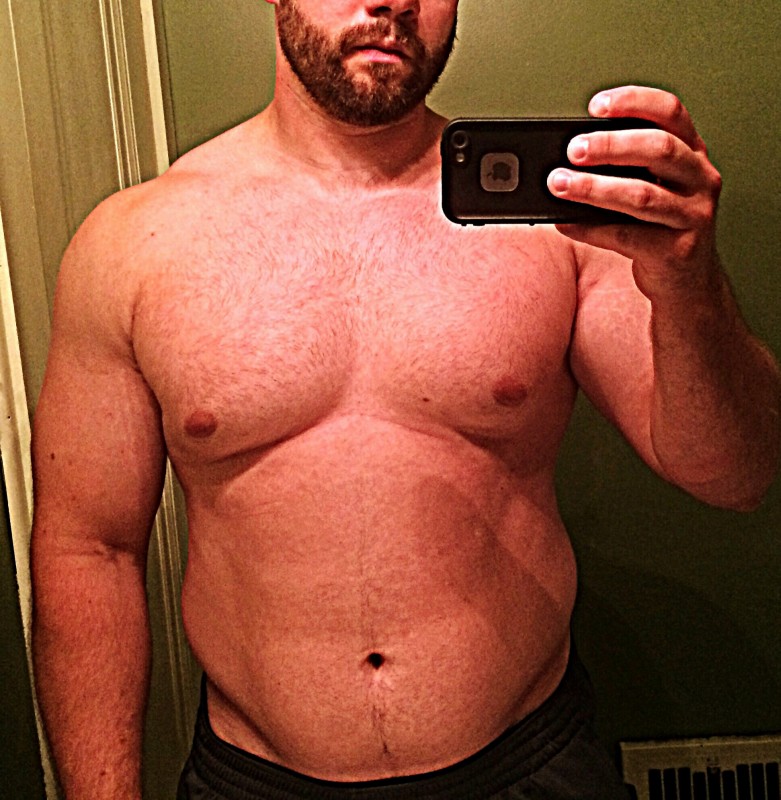
This past year I competed in APF Senior Nationals where I weighed 238 pounds and finished with a 1830-pound powerlifting total. Five and a half months later I competed at WPC Worlds at 212 pounds and finished with a 1879-pound total total, losing about 26 pounds and increasing my total by 49 pounds. While I still have a long way to go in getting stronger, I was able to reach several fat loss goals and still hit PRs on all my lifts in a meet. There were certain keys to making this happen successfully that I believe will help you in your own nutritional pursuits, but first I’ll go into my goals and how I approached them.
Following APF Senior Nationals I evaluated my training and mapped out the 23 weeks before Worlds. I knew what weaknesses I needed to address (and continue to address now), but also knew that the weight I gained in the previous year wasn’t being matched by the strength improvements that should have accompanied it. I was sitting at around 240 pounds but wasn’t built like I needed to be in order to be competitive in the 242-pound weight class. I was eating without any rhyme or reason and along with gaining a lot of fat I was dealing with digestive issues that affected my training. I decided that I would utilize the next several months to do the following:
- Regiment my eating and determine foods that wouldn’t give me digestive issues.
- Slowly drop some weight.
- After seeing where my weight was after about 12 weeks, start to slowly build back up with a goal to fuel my training as opposed to just eating randomly.
- As the weeks progressed, determine whether to compete in 242 or 220 depending on where my weight was and how my strength was progressing. I didn’t at this time want to make a large weight cut right before the meet, so I wanted any sizable weight changes to be further out from competition.
I have tried different nutrition protocols in the past that eliminated or cycled various macronutrients (like carb backloading or ketogenic diets). But for these goals I wanted to take a very basic, slow and steady approach. I got a lot of really good insight from elitefts team member Ben Hartman on different ways I could approach this. The following is a brief outline of what I did nutritionally to reach my goals. I am not a dietician or diet coach, and this isn’t a recommendation or prescription for a diet. This is to give perspective on what I did for myself to give context for the important principles for success that I will outline later in this article. That being said, here is a summary of the steps I took to lose body fat and increase my powerlifting total over six months:
- Determined how many calories on average I was currently eating (was very inconsistent, but averaged 3,300 at the time with not enough protein, too much fat, too low overall calories).
- Recomposed that calorie amount with a different macronutrient breakdown (higher protein, more balanced fat and carbs).
- Determined what foods I could use to consistently meet those macronutrient goals. (Practical foods I knew I would make, could afford, wouldn’t give me digestive problems, and provided enough fiber and micronutrients.)
- Spent the first few weeks eating those foods consistently, then began to drop a small amount of calories from carbs or fat every two weeks and monitor weight loss and strength levels.
- After dropping down to about 218 over the course of 14 weeks, began slowly building my calories back up through increases mostly in carbohydrates.
- As my metabolism improved and body got used to eating more consistently, I actually continued to lose more weight as I bumped up my carbs. As I approached my competition I took bigger increases in carb intake to keep my weight from getting too low, and competed at 212 pounds, eating 3,600 calories (as opposed to the 3,300 I started with when I was 238 pounds).
- At this point in time I’m weighing 215 pounds and eating 3,800 calories on average per day. My goal is to continue to slowly increase my calories and fill out the 220-pounds weight class.
I left out some of the details on purpose because I don’t want the specifics to take away from the big picture of why this worked for me. It has been well documented and well discussed how different dietary approaches work differently for different people; whether it’s for psychological reasons, or reasons relating to physiology, training, or other variables. Some of the exact foods, nutrient timing, macro breakdown, and other components of a diet will likely differ for other lifters, and we have plenty of great nutritional resources and coaches on this site more knowledgeable than I. But there are several principles that I believe made this plan successful that can also make you successful, even with a different approach to fat loss. I don’t believe that there are any magic keys to fat loss but rather a multitude of proven dietary tools that when put into the right structure, can work great if you approach them the right way (just like training). So no matter what type of approach to nutrition you take, I believe these three keys will help ensure your success in reaching your dietary goals.
Slow and Steady Wins the Race
Many popular diets (just like programs), promise quick and dramatic results. These results are usually promised by way of dramatic diet changes or complete elimination of a type of food or macronutrient. While some may choose to take this approach (and it can work), I believe, as strength athletes, we need to keep in consideration how changes are going to affect our training. I also wanted to make sure I was losing body fat without completely destroying my strength. Any time you lose a good measure of bodyweight your strength and leverages will be affected, but the effects can be minimized by taking a slower and more strategic approach. The issue of sustainability is also important. I would rather lose 20 pounds over 20 weeks and keep the weight off, than lose 20 pounds in two weeks only to gain it back as soon as you eat a meal outside of your diet plan (this does not include weight cuts for competition). Over six months I averaged one to two pounds of weight loss per week. While some weeks were different, overall it was very consistent. A slower approach may take more patience, but it will pay off in the long run. This will also prevent issues with adjusting to new bodyweight too close to a meet (especially if you compete in gear).
Minimal Changes Means Long-Term Progress
Another concept that also applies to training is the use of the minimum effective dose to create physiological changes. When dropping weight I only made changes every two weeks, and only dropped calories when necessary. If I continued to drop weight during a second week without making changes, then I waited until my weight stalled again to drop calories. The more you can get out of small changes the better, and this will help your metabolism as well. Sure you could go from eating fast food every day to eliminating carbs completely in the matter of a week and lose a considerable amount of weight. But where do you go from there? What else is there to take away? It’s always important to know what the next step is after a dietary plan. If steps A, B, and C leave you eating barely anything, does step D include building your calories back up? If so, how? These questions can have various answers, but they are important questions to ask when approaching a nutrition plan.
There Are No Shortcuts
While I think complete elimination of foods too quickly can be detrimental, the idea that self-restraint won’t be necessary is naive if you expect to make effective changes. Sometimes I think there’s this idea that dietary changes should never be restrictive or difficult. While I think any good dietary plan will leave you room to enjoy life and enjoy different foods, bottom line is to make progress you’re going to have to be disciplined. It won’t always be fun and there will be times it really sucks. There were days during those final weeks of dropping calories where I was pretty hungry and craving junk food, but I stuck with the plan and it paid off. After staying consistent and disciplined for six months, I can afford to be more flexible and less strict with my tracking. Dieting shouldn’t make you miserable, but if it’s an effective plan chances are you’re going to have times where you will have to use perseverance (just like with training).
Those were just a few keys that were important in making my body composition changes over the past six months. While everyone’s individual approach to dietary changes will differ, I believe those keys will make a big difference in determining long-term progress vs. short-term burnout. These principles not only apply to weight loss, but structured weight gain as well. Be smart and disciplined, and once you determine your goals, stick with them. For many younger and beginning lifters, weight loss shouldn’t be a concern as they likely just need to put on more weight and learn to fuel training consistently. But for many competitive strength athletes, improving body composition will only make you a stronger and healthier lifter, and set you up for long-term success.
There are many similarities between training and nutrition and what makes each successful. Focus on the big picture and remember that no quick fixes will ever replace planning, discipline, and consistency.













You said there were better diet coaches on the site.
But I couldn't find any diet plans, any pointers?
My specific foods I ate changed based on my digestive response and how my weight moved. Like I mention in the article, I dropped calories every two weeks from either fat or carbs, and composed my food based on what would keep me full and would be easy to make/eat, especially with work and when my carbs were lower. My training didn't change during this time, I just moved more of my carbs around my workouts when they were lower to help fuel training.